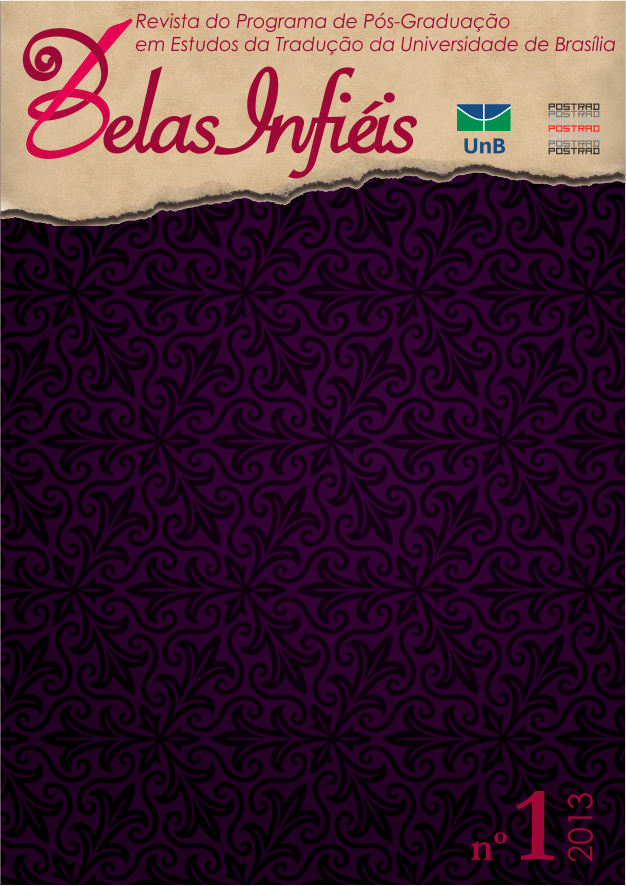“PRIMAVERA EM FIALTA”:
(RE)LER, (RE)TRADUZIR, (RE)ESCREVER COM NABÓKOV
DOI:
https://doi.org/10.26512/belasinfieis.v2.n1.2013.11221Palabras clave:
Nabókov, Vladímir Vladímirovitch, tradução, literatura russa, “Primavera em Fialtal”Resumen
Ilustre desconhecido na América Latina como um todo e no Brasil em particular, os leitores não reconhecem o nome de Vladímir Nabókov[i] (1899-1977), a não ser quando se invoca Lolita (1955), e não sabem que muitos dos textos que leem foram escritos em russo.
Apesar de ter escrito em torno de 70 contos, figurar nas mais diversas antologias do gênero e inúmeros serem incluído nas bibliografias de disciplinas em universidades do mundo todo, há relativamente poucos estudos dedicados exclusivamente ao conto nabokoviano e a maioria de acesso mais restrito aos brasileiros.
“Primavera em Fialta” (1938) retrata descontinuidades, perdas e separações; os monólogos interiores e fluxos de consciência refletem a relatividade e a não linearidade espaço-temporal, a recorrência do tempo mitológico e cíclico, girando em torno de remissões, alusões e elisões. Segundo Barbara Heldt Monter (1970), o referido conto é a obra-prima do período russo de Nabókov; paradigmático, não apenas desse primeiro momento de sua vida literária, que é, de modo geral, desconhecida dos estudiosos e leitores brasileiros, mas também revela a poética da obra de Nabókov-Sírin como um todo. “Primavera em Fialta” é um recorte do conto nabokoviano por excelência e pode, portanto, ser entendido como metatexto nabokoviano.
“Primavera em Fialta” foi incluído na Nova antologia do conto russo, Editora 34 (2011). Além de ser a primeira tradução do russo de uma obra de Nabókov publicada no Brasil, é também a primeira vez que Nabókov figura em uma antologia brasileira de contos russos.
[i] Neste artigo, a grafia de Nabókov e Berbérova levará acento, salvo nas Referências Bibliográficas, referentes a textos não traduzidos no Brasil.
Descargas
Citas
AGUIAR, R. F. Memória de tradutora com Rosa Freire d’Aguiar.Florianópolis: Escritório do Livro NUT/UFSC, 2004.
BERBEROVA, N. Nabokov in the thirties. In: APPEL JR., A.; NEWMAN, C. (Ed.). Nabokov criticism, reminiscences, translations and tributes. Evanston: Northwestern University Press, 1970. p. 147-159.
BEZERRA, P. (2002). Prefácio. In: DOSTOIÉVSKI, F. O idiota.3. ed. Tradução dePaulo Bezerra. São Paulo: Editora 34,2006.p. 7-15.
BOYD, B. On the origin of stories: evolution, cognition and fiction.Belknap Press of Harvard University Press, 2009.
CONNOLLY, J. W. (Ed.). Introduction. In: ____. The Cambridge companion to Nabokov.Cambridge: Cambridge University Press, 2005. p. 1-8.
FERREIRA, M. Estratégias textuais de ressignificação do sentido na tradução do texto artístico. In:____.Língua e literatura. SãoPaulo: Humanitas, 2000(n. 26). p.197-214.
GOTLIB, N.B. Teoria do conto. 8. ed. São Paulo: Ática, 1998.
HOUAISS, A. Dicionário eletrônico Houaiss da língua portuguesa.Rio de Janeiro: Objetiva. Versão 1.0. 1 [CD-ROM]. 2001.
JOHNSON, R. Nabokov’s Stories ”“Introduction. In: <http://www.mantex.co.uk/2009/09/24/01-nabokovs-stories-introduction>.Acesso em: 05 dez. 2009.
MONTER, B. H. “Spring in Fialta”: the choice that mimics chance. In: APPEL JR., A.; NEWMAN, C. (Ed.). Nabokov criticism, reminiscences, translations and tributes. Evanston: Northwestern University Press, 1970. p. 128-135.
NABOKOV, D. Preface. In: ____. The stories of Vladimir Nabokov. New York: Vintage, 1997. p. xiii-xvi.
NABOKOV, V. Lectures on literature. Edited by Fredson Bowers. New York: Harvest, 1980.
_____________. Selected letters 1940-1977.Edited by Dmitri Nabokov & Matthew J. Bruccoli. San Diego: Harcourt, 1989.
_____________. The stories of Vladimir Nabokov. New York: Vintage, 1997.
_____________. Speak, memory: An Autobiography Revisited. New York: Knopf, 1999.
SCHNAIDERMAN, B. Entrevista: Boris Schnaiderman. Entrevista concedida a vários especialistas. Revista de Estudos Orientais, São Paulo. FFLCH ”“USP, n. 5, p. 9-21,2006.
______________. Poesia russa moderna. São Paulo: Perspectiva, 2001.
VOLKOV, S. São Petersburgo: uma história cultural. Tradução de Marco Aarão Reis. São Paulo: Record, 1997.
Descargas
Publicado
Cómo citar
Número
Sección
Licencia
Copyright Statement
Given the public access to this journal, the texts are free to use but requires the recognition of the original authorship and initial publication in this journal to be properly stated.
The journal allows the use of works published for non-commercial purposes, including the right to submit the work to publicly accessible databases. Published contributions are the sole and exclusive responsibility of the author(s).
- When submitting papers to be evaluated by the Belas Infiéis journal, the author(s):
- Declare that the contents of the contributions are original and of their original creation, being entirely responsible for their content if there is an objection by third parties.
- Claim to be aware that they should not commit academic plagiarism.
- Declare that the manuscript has not been published, completely or partially, in Portuguese or another language. If it is a translation it should be submitted to the Translated Articles section.
- Declare that the manuscript is not being evaluated by other journals.
- Declare that the manuscript was not submitted to another journal simultaneously.
- Commit(s) to inform the journal of any kind of error or inaccuracy in their contribution (published, in evaluation or in editing) and to collaborate with the editors to make due corrections of the article (when in evaluation or editing) or erratum/retraction (after publication).
- Declare that there is no conflict of interest regarding the published work.
- Authorize its release if it is accepted for publication without any kind of monetary compensation.
- Agree to assign non-exclusive rights to publication to the magazine, remaining free to make their contribution available in other media as long as the publication of the first version in Belas Infiéis magazine is mentioned. They also authorize Belas Infiéis to assign their texts for reproduction in content indexers, virtual libraries and similar platforms.
- Maintain copyright and grant the journal the right of first publication, the work being licensed under theCreative Commons Attribution License.
- Is/Are allowed and encouraged to publish and distribute their work online after the editorial process, which may increase the impact and citation of the published work.
- Authorize the editorial team to make textual adjustments and to adapt the article to the publication rules, when necessary.



















